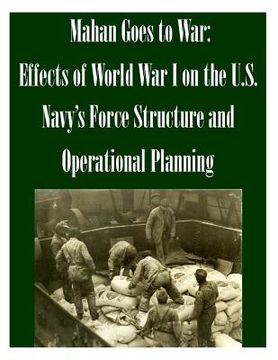Compartir
Mahan Goes to War: Effects of World War I on the U.S. Navy's Force Structure and Operational Planning (en Inglés)
U. S. Army Command and General Staff Col
(Autor)
·
Createspace Independent Publishing Platform
· Tapa Blanda
Mahan Goes to War: Effects of World War I on the U.S. Navy's Force Structure and Operational Planning (en Inglés) - U. S. Army Command and General Staff Col
S/ 89,16
S/ 178,31
Ahorras: S/ 89,16
Elige la lista en la que quieres agregar tu producto o crea una nueva lista
✓ Producto agregado correctamente a la lista de deseos.
Ir a Mis Listas
Origen: Estados Unidos
(Costos de importación incluídos en el precio)
Se enviará desde nuestra bodega entre el
Viernes 09 de Agosto y el
Viernes 23 de Agosto.
Lo recibirás en cualquier lugar de Perú entre 2 y 5 días hábiles luego del envío.
Reseña del libro "Mahan Goes to War: Effects of World War I on the U.S. Navy's Force Structure and Operational Planning (en Inglés)"
A.T. Mahan formulated a theory of sea power that proclaimed the capital ship-centered battle fleet essential to any great maritime nation's long-term prosperity. He also presented a beguilingly simple operational concept based on the teachings of Jomini. His ideas quickly became dogma in the world's navies, including the U.S. Navy. In the decades before World War I, the U.S. Navy reflected Mahan's emphasis on the battleship and fighting as a concentrated fleet. The naval conflict between Germany and Great Britain in World War I did not resemble Mahan's vision for what war at sea between two great powers should look like. Rather than consisting of decisive battles between fleets of capital ships, the War involved distant blockade, raids, mining, and especially commerce raiding by German submarines. Despite the advantage of almost three years of observing the European conflict, the U.S. Navy did little to prepare for this new kind of war. It entered the War in April, 1917 with a "top-heavy" force of battleships, and operational plans completely unsuited to the antisubmarine conflict it would undertake. This book attempts to determine the effects of World War I, a decidedly non-Mahanian war, on the U.S. Navy's force structure and operational planning.
- 0% (0)
- 0% (0)
- 0% (0)
- 0% (0)
- 0% (0)
Todos los libros de nuestro catálogo son Originales.
El libro está escrito en Inglés.
La encuadernación de esta edición es Tapa Blanda.
✓ Producto agregado correctamente al carro, Ir a Pagar.

